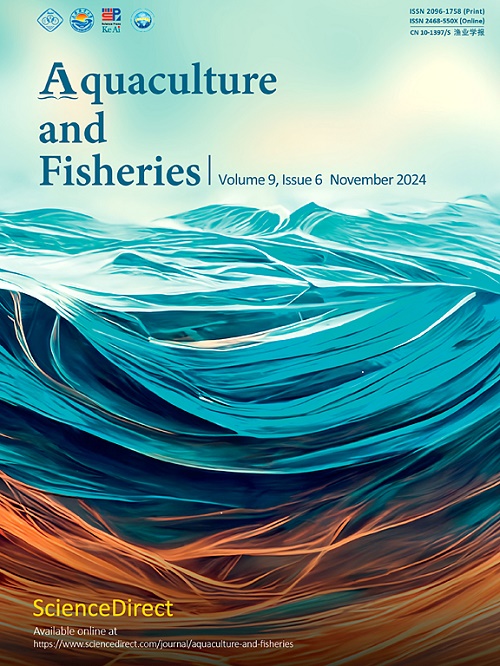Phenylhydrazine-induced haemolysis disturbed iron pool homeostasis and activated expression pattern of FPN1 in the intestine of grass carp (Ctenopharyngodon idella)
Q1 Agricultural and Biological Sciences
引用次数: 0
Abstract
As the only molecule that can transport iron to the cell exterior, the ferroportin 1 (FPN1) plays a key role in regulating the homeostasis of the iron ion. However, the function of FPN1 in teleost is remains unclear. In this study, the fpn1 gene was cloned from grass carp and its characteristics were studied. The results showed that grass carp Fpn1 protein contains eight transmembrane domains, which are similar to the amino acid sequences of different species. The tissue distribution of fpn1 was investigated by quantitative real-time PCR (qRT-PCR), which showed that the expression of fpn1 was the highest in the liver, followed by the spleen and muscle. Secondly, the haemolysis model of grass carp was established by the injection of phenylhydrazine (PHZ), and the effect of Fpn1 on the intestine in during haemolysis was explored. The determination data revealed that the PHZ-induced haemolysis increased the number of goblet cells in intestinal, as well as malondialdehyde (Mda), decreased glutathione peroxidase 4 (Gpx4) content in foregut. The result of tissue immunofluorescence assay showed that the PHZ-induced haemolysis modulated the expression of iron metabolism related genes, including Fpn1 and Tfr1 (transferrin receptor 1) in the intestine. Further determination data suggested that the iron deposition and apoptosis were higher in PHZ treatment group than that of the group. Taken together, the PHZ-induced haemolysis destroyed the iron homeostasis in intestinal and caused oxidative damage, the data of this study lays a foundation for the study of the mechanisms of intestinal iron homeostasis and provides a theoretical basis for understanding intestinal healthy.
苯肼诱导的溶血扰乱了草鱼肠道中铁池的平衡并激活了 FPN1 的表达模式
作为唯一能够将铁转运到细胞外的分子,铁转运蛋白1 (FPN1)在调节铁离子的稳态中起着关键作用。然而,FPN1在硬骨鱼中的功能尚不清楚。本研究从草鱼中克隆了fpn1基因,并对其特性进行了研究。结果表明,草鱼Fpn1蛋白含有8个跨膜结构域,这些结构域与不同物种的氨基酸序列相似。采用实时荧光定量PCR (qRT-PCR)检测fpn1的组织分布,结果显示fpn1在肝脏中表达量最高,其次是脾脏和肌肉。其次,通过注射苯基肼(phenylhydrazine, PHZ)建立草鱼溶血模型,探讨Fpn1在溶血过程中对肠道酶的影响。测定数据显示,phz诱导的溶血增加了肠道杯状细胞的数量,降低了前肠丙二醛(Mda)和谷胱甘肽过氧化物酶4 (Gpx4)的含量。组织免疫荧光分析结果显示,phz诱导的溶血可调节肠内铁代谢相关基因Fpn1和Tfr1(转铁蛋白受体1)的表达。进一步测定数据表明,PHZ治疗组铁沉积和细胞凋亡明显高于对照组。综上所述,phz诱导的溶血破坏了肠道内铁稳态并引起氧化损伤,本研究数据为肠道铁稳态机制的研究奠定了基础,为理解肠道健康提供了理论依据。
本文章由计算机程序翻译,如有差异,请以英文原文为准。
求助全文
约1分钟内获得全文
求助全文
来源期刊

Aquaculture and Fisheries
Agricultural and Biological Sciences-Aquatic Science
CiteScore
7.50
自引率
0.00%
发文量
54
审稿时长
48 days
期刊介绍:
 求助内容:
求助内容: 应助结果提醒方式:
应助结果提醒方式:


